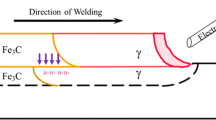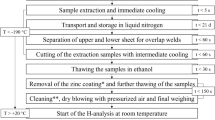Abstract
Industry and research have long desired the establishment of standards for weldability testing in regards to hydrogen-assisted cold cracking formation. This would have the obvious advantage of allowing data to be reliably compared between different research labs. But making decisions regarding standards requires some careful thought and agreement on i) how test parameters affect test results, ii) what exactly needs to be measured, and iii) how test results should be interpreted and reported. Our depth of understanding on these points has matured significantly over time and, while there is not always universal agreement, it is at least possible to start highlighting factors important to standards. This paper examines these factors, including the welding parameters, restraint, hydrogen, and cracking index. When comparing different alloys having different thermal characteristics, the use of constant welding parameters (common practice) will result in variable weld penetration and weld pool shape, which can influence grain shape and microstructural features, which can result in inequitable weldability comparisons. Welding on test coupons having different dimensions can affect restraint, which will influence the residual stresses around the weldment. High restraint usually results in higher crack susceptibility. Also, hydrogen content present in a weldment depends on the thermal history, welding parameters, and surrounding atmosphere humidity, with high hydrogen contents associated to great cracking susceptibility. Finally, the selection of an appropriate cracking index is required for data analysis. Quantifications of crack length and minimum preheat temperature are common indexes used for comparison. Critical stress and hydrogen content are other indexes. But how well these indexes actually represent weldability are contentious issues. This paper will examine and quantify these issues in detail, thus providing the reader with an appreciation of all things that must be considered when preparing a standardized procedure for weldability testing.
Similar content being viewed by others
References
Graville B (1986) A survey review of weld metal hydrogen cracking. Weld World 24(9/10):190–198
B.A. Graville (1995) Interpretive report on weldability tests for hydrogen cracking of higher strength steels and their potential for standardization. WRC Bull 400
Yurioka N, Suzuki H (1990) Hydrogen assisted cracking in c-mn and low alloy steel weldments. Int Mater Rev 35(4):217–249
Glover A and Rothwell B (1999) Specifications and practices for hydrogen crack avoidance in pipeline girth welds, In: First International Conference on Weld Metal Hydrogen Cracking in Pipeline Girth Welds, Wollongong, Australia, 13.1-13.18. WTIA
Kannengiesser T, Boellinghaus T (2013) Cold cracking tests—an overview of present technologies and applications. Weld World 57:3–37
North TH, Rothwell AB, Glover AG, and Pick RJ (1982) Weldability of high strength line pipe steels. Weld J, August, 243s-257s
Coniglio N, Linton V, Gamboa E (2010) Coating composition, weld parameter, and consumable conditioning effects on weld metal composition in shielded metal arc welding. Sci Technol Weld Join 15(5):361–368
Natalie CA, Olson DL, Blander M (1986) Physical and chemical behavior of welding fluxes. Annu Rev Mater Sci 16:389–413
Coniglio N, Barbaro F, Linton VM, Gamboa E, and Kurji R (2010) Hydrogen assisted cold cracking susceptibility of weld metal deposited by cellulosic shielded metal arc welding consumables. In: Proceedings of the 8th International Pipeline Conference, IPC2010, Calgary, Canada. IPC2010-31680
Hart P (1986) Effects of steel inclusions and residual elements on weldability. Met Constr, October, 610–616
Talas S (2010) The assessment of carbon-equivalent formulas in predicting the properties of steel weld metals. Mater Des 31(5):2649–2653
Yurioka N, Kasuya T (1995) A chart method to determine necessary preheat in steel welding. Weld World 35(5):327–334
Dearden J, O’Neil H (1940) A guide to the selection and welding of low alloy structural steels. Trans Int Weld 3(10):203–214
Suzuki H, Tamura H (1961) Weldability of high strength steels evaluated by synthetic HAZ ductility test. Rep NRIM 3(1):47–59
Hannerz NE (1980) The influence of silicon on the weldability of mild and high tensile structural steel, IIW Doc. IX-1169-80
Uwer D and Hohne H (1991) Determination of suitable minimum preheating temperatures for the cold-crack-free welding of steels, IIW Doc. IX-1631-9
Itoh Y, Bessho K (1968) Cracking parameter of high strength steels related to HAZ cracking. J Jpn Weld Soc 37(9):983–989
Duren C (1985) Equations for the prediction of cold cracking in field-welding large diameter pipes, IIW Doc. IX-1356-85
Graville BA Cold cracking in welds in HSLA steels, Proc. Conf. on Weldability of HSLA Structural Steel, Rome, ASM
Yurioka N, Ohshita S, Tamehiro H (1981) Study on carbon equivalents to assess cold cracking tendency in steel welding. AWRA Symposium on Pipeline Welding in the 80’s, Melbourne
Lazor RB and Graville BA (1983) Effect of microalloying on weld cracking in low carbon steels. Can Welder and Fabricator, July, 21–23
Kasuya T, Yurioka N (1995) Determination of necessary preheat temperature to avoid cold cracking under varying ambient temperature. ISIJ Int 35(10):1183–1189
Kou S (2002) Welding metallurgy, 2nd edn. Wiley, New York
Alam N, Dunne D, and Barbaro F (1999) Weld metal crack testing for high strength cellulosic electrodes. In: First International Conference on Weld Metal Hydrogen Cracking in Pipeline Girth Welds, Wollongong, Australia, 9.1-9.23. WTIA
Signes EG, Howe P (1988) Hydrogen-assisted cracking in high-strength pipeline steels. Weld J 67(8):163s–170s
Kurji R, Griggs J, Linton V, Kotousov A, Gamboa E, Ghomashchi R, and Coniglio N (2013) An improved welding Institute of Canada test for evaluation of high strength pipeline steel weldability. In: Proc. 6th Pipeline Technology Conference, Ostend
Magudeeswaran G, Balasubramanian V, Madhusudhan Reddy G (2008) Hydrogen induced cold cracking studies on armour grade high strength, quenched, and tempered steel weldments. Int J Hydrog Energy 33:1897–1908
Sawhill JM Jr, Dix AW, Savage WF (1974) Modified implant test for studying delayed cracking. Weld J 53(13):554s–560s
Vasudevan R, Stout RD and Pense AW (1981) Hydrogen-assisted cracking in HSLA pipeline steels, Weld J, Sept, 155s-168s
Beachem CD (1972) A new model for hydrogen-assisted cracking (Hydrogen “Embrittlement”). Metall Trans 3:437–451
Law M, Nolan D, Holdstock R (2008) Method for the quantitative assessment of transverse weld metal hydrogen cracking. Mater Charact 59:991–997
Peterneder E and Königshofer H (1999) Capabilities and limitations of cellulosic electrodes—a producer’s perspective. In: First International Conference on Weld Metal Hydrogen Cracking in Pipeline Girth Welds, Wollongong, Australia, 17.1-17.17. WTIA
Sarrafan S, Ghaini FM and Rahimi E (2010) Weld metal hydrogen cracking in transmission pipelines construction, In: Proceedings of the 8th International Pipeline Conference IPC2010, Calgary, Canada. IPC2010-31240
Alam N, Dunne D, Squires I, Barbaro F and Feng B (1996) Weldment cold cracking—the effect of hydrogen and other factors, In: Proceedings of Joint Seminar Hydrogen Management in Steel Weldments, Melbourne, Australia, 49–60. WTIA
Kinsey AJ. The welding of structural steels without preheat, Weld J, 79 (4), 79s-88s
Graville BA, McParlan M (1974) Weld-metal cold cracking. Met Constr Br Weld J 6(2):62–63
Sterjovski Z, Pitrun M, Nolan D, Dunne D, Norrish J (2007) Artificial neural networks for predicting diffusible hydrogen content and cracking susceptibility in rutile flux-cored arc welds. J Mater Process Technol 184:420–427
McParlan M, Graville BA (1976) Hydrogen cracking in weld metals. Weld J 55(4):95s–102s
Vasudevan R, Stout RD, Pense AW (1980) A field weldability test for pipeline steels—part I. Weld J 59(3):76s–84s
Suzuki H, Yurioka N, Okumura M (1983) A new cracking parameter for welded steels considering local accumulation of hydrogen. Weld World 21(5/6):110–132, Doc. IIS/IIW-755-83
Ushio M, Sugitani Y, Kanayama K, Aida I, Hara N and Nakano T (1999) Cracking in GMAW pipeline girth welds based on experiences in pipeline construction in Japan, in: First International Conference on Weld Metal Hydrogen Cracking in Pipeline Girth Welds, Wollongong, Australia, 10.1-10.19. WTIA
Katz Y, Tymiak N, Gerberich WW (2001) Nanomechanical probes as new approaches to hydrogen/deformation interaction studies. Eng Fract Mech 68(6):619–646
Costin WL, Lavigne O, Linton V, Brown IH, Kotousov AG, Barbaro FJ and Ghomashchi R (2013) Micromechanical examination of the relationship between weld metal microstructure and hydrogen assisted cold cracking, In: Proc. 6th Pipeline Technology Conference, Ostend
Bailey N (1994) Weldability of ferritic steels. Abington Publishing
Lippold JC (2005) Recent developments in weldability testing. In: Hot cracking phenomena in welds, Springer: 271–290
Cross CE, Boellinghaus T (2006) The effect of restraint on weld solidification cracking in aluminium. Weld World 50:51–54
Yurioka N (1999) Predictive methods for prevention and control of hydrogen assisted cold cracking, In: First International Conference on Weld Metal Hydrogen Cracking in Pipeline Girth Welds, Wollongong, Australia, 2.1-2.16. WTIA
Barbaro FJ (1999) Types of hydrogen cracking in pipeline girth welds, In: First International Conference on Weld Metal Hydrogen Cracking in Pipeline Girth Welds, Wollongong, Australia, 11.1-11.15. WTIA
Hirth JP (1980) Effect of hydrogen on the properties of iron and steel. Metall Trans 11A:861–890
Padhy GK, Komizo Y (2013) Diffusible hydrogen in steel weldments. Trans JWRI 42:39–62
Fletcher L, Yurioka N (2000) A holistic model of hydrogen cracking in pipeline girth welding. Weld World 44(2):29–36
Fletcher L and Yurioka N (1999) A holistic model of hydrogen cracking in pipeline girth welding, In: First International Conference on Weld Metal Hydrogen Cracking in Pipeline Girth Welds, Wollongong, Australia, 12.1-12.14. WTIA
A. Glover and B. Graville (1999) The risk of hydrogen cracking in multipass welds and its effect upon procedure design, In: First International Conference on Weld Metal Hydrogen Cracking in Pipeline Girth Welds, Wollongong, Australia, 9.1-9.23. WTIA
Author information
Authors and Affiliations
Corresponding author
Rights and permissions
About this article
Cite this article
Kurji, R., Coniglio, N. Towards the establishment of weldability test standards for hydrogen-assisted cold cracking. Int J Adv Manuf Technol 77, 1581–1597 (2015). https://doi.org/10.1007/s00170-014-6555-3
Received:
Accepted:
Published:
Issue Date:
DOI: https://doi.org/10.1007/s00170-014-6555-3




